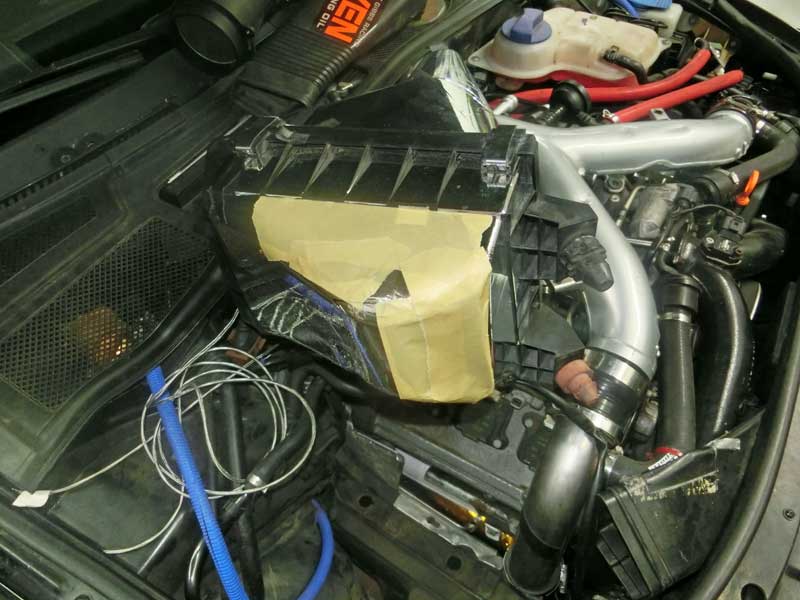One comment made to me regarding the findings about intake temperatures when applying foil to the airbox was that the Darintake modification will nullify any benefit that foil wrapping provides. I have made this Darintake modification to my stock airbox as it allows more air through the airbox and on Stage 3 cars there can be sufficient airflow restriction in the stock airbox to cause the accordion hose to collapse if the modification is not performed.
Previously I have recorded temperatures on the pre-air filter side of the airbox with the Darintake holes covered and uncovered. Those results indicated that the holes in the airbox could allow the pre-filter side of the airbox to warm more quickly than when the holes were blocked. That finding does not necessarily prove that the pre-turbo air temperature is lower when the airbox is unmodified, it only suggests it might be.
With the current state of my S4 being set to take temperature readings it would be a trivial matter to block the holes I have made in the airbox and see what happens to the intake air temperatures.

So that’s what I did. Out came the tape and I covered over the holes in the side and bottom of the airbox, limiting airflow through the airbox to the pure stock paths.
With the airbox sealed I made a set of drives along my daily commute route, one in the morning and one in the afternoon, recording the temperature inside the airbox post-air filter and in the inlet pipe prior to the turbochargers.
Results for the temperature rise in the airbox above the ambient air temperature are shown on the chart below for the morning drive:

Readings with the Darintake modification holes open are shown in Red and indicated in the Legend with +DI. It’s clear that just past halfway in the drive the +DI temperature begins to rise faster for a couple of minutes before mirroring the -DI (no Darintake modification) temperatures. The jump coincided with a longer delay at a stoplight in the +DI case.
These results give some support to the thought that the Darintake holes allow the intake air temperatures to rise more than with a stock airbox. Looking at the temperature a little further down the intake path should make the picture clearer. A comparison of pre-turbo intake air temperatures for the same drives is shown below.

Unlike inside the airbox, the temperature further along the intake path does not show a significant difference, in fact toward the end of the drive the temperature curves with the Darintake mod and without are essentially indistinguishable.
I also made readings during the afternoon drive which was warmer and also entails some longer stop and go driving during the first part of the drive. Temperatures inside the airbox are shown below:

The drive in traffic meant there were delays that induced a shift in the time axis between the two data sets. Being stuck at a light for a minute where the prior drive got through without stopping caused the rise of temperatures and subsequent fall as steady state driving was achieved, to occur at different points along the time axis.
The differences are less pronounced on this afternoon chart but it looks like the -DI case cools slightly faster under steady state driving and achieves about a 1-2 degree cooler steady state, although the +DI case had a slowdown that did not occur in the -DI case.
Again looking at the temperature pre-turbo:

As before the differences are very minor, the -DI case may cool a slight bit quicker once under steady state, but without taking more data the result is inconclusive. Interestingly the temperature toward the end of the drive is higher in the -DI case, contradicting the theory that the Darintake holes allow warmer air into the intake.
Conclusion:
The addition of the Darintake holes may have some affect on the air temperature inside the airbox but the impact appears limited to the airbox and does not significantly affect the intake air temperature going into the turbocharger.
With additional drives and more tightly controlled conditions it may be possible to break out differences between the two configurations, but given the lack of clear performance differences over a couple of drives under similar conditions I believe it is safe to say that the Darintake modification does not affect the intake air temperature going into the turbocharger in a significant way.
